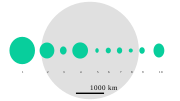
8 Flora
Encyclopedia
8 Flora is a large, bright main-belt asteroid
. It is the innermost large asteroid: no asteroid closer to the Sun has a diameter above 25 kilometres or two-elevenths that of Flora itself, and not until the tiny 149 Medusa
was discovered was a single asteroid orbiting at a closer mean distance known. It is the seventh brightest asteroid with a mean opposition magnitude
of +8.7. Flora can reach a magnitude of +7.9 at a favorable opposition near perihelion, such as occurred in November 2007. Flora may be the residual core of an intensely heated, thermally evolved, and magmatically differentiated
planetesimal which was subsequently disrupted.

on October 18, 1847. It was his second asteroid discovery after 7 Iris
.
The name Flora was proposed by John Herschel
, from Flora, the Latin goddess
of flowers and gardens, wife of Zephyrus (the personification of the West wind), and mother of Spring. The Greek equivalent is Chloris
, who has her own asteroid, 410 Chloris
, but in Greek Flora is also called Chloris (8 Χλωρίς).
(β, λ) = (16°, 160°) with a 10° uncertainty. This gives an axial tilt
of 78°, plus or minus ten degrees.
Flora is the parent body of the Flora family
of asteroids, and by far the largest member, comprising about 80% of the total mass of this family. Nevertheless, Flora was almost certainly disrupted by the impact(s) that formed the family, and is probably a gravitational aggregate of most of the pieces.
Flora's spectrum
indicates that its surface composition is a mixture of silicate
rock (including pyroxene
and olivine
) and nickel
-iron
metal. Flora, and the whole Flora family
generally, are good candidates for being the parent bodies of the L chondrite
meteorites. This meteorite type comprises about 38% of all meteorites impacting the Earth.
star. Flora had come to opposition on 1917 February 13, 40 days earlier. This mistake was uncovered only in 1995.
In the film The Green Slime
, the asteroid Flora falls out of orbit and is on a collision course with Earth.
Asteroid
Asteroids are a class of small Solar System bodies in orbit around the Sun. They have also been called planetoids, especially the larger ones...
. It is the innermost large asteroid: no asteroid closer to the Sun has a diameter above 25 kilometres or two-elevenths that of Flora itself, and not until the tiny 149 Medusa
149 Medusa
149 Medusa is a bright-coloured, stony main-belt asteroid.It was discovered by J. Perrotin on September 21, 1875 and named after the Gorgon Medusa, a snake-haired monster in Greek mythology....
was discovered was a single asteroid orbiting at a closer mean distance known. It is the seventh brightest asteroid with a mean opposition magnitude
Apparent magnitude
The apparent magnitude of a celestial body is a measure of its brightness as seen by an observer on Earth, adjusted to the value it would have in the absence of the atmosphere...
of +8.7. Flora can reach a magnitude of +7.9 at a favorable opposition near perihelion, such as occurred in November 2007. Flora may be the residual core of an intensely heated, thermally evolved, and magmatically differentiated
Planetary differentiation
In planetary science, planetary differentiation is the process of separating out different constituents of a planetary body as a consequence of their physical or chemical behaviour, where the body develops into compositionally distinct layers; the denser materials of a planet sink to the center,...
planetesimal which was subsequently disrupted.

Discovery and naming
Flora was discovered by J. R. HindJohn Russell Hind
John Russell Hind FRS was an English astronomer.- Life and work :John Russell Hind was born in 1823 in Nottingham, the son of lace manufacturer John Hind, and was educated at Nottingham High School...
on October 18, 1847. It was his second asteroid discovery after 7 Iris
7 Iris
7 Iris is a large main-belt asteroid. Among the S-type asteroids, it ranks fifth in geometric mean diameter after Eunomia, Juno, Amphitrite and Herculina....
.
The name Flora was proposed by John Herschel
John Herschel
Sir John Frederick William Herschel, 1st Baronet KH, FRS ,was an English mathematician, astronomer, chemist, and experimental photographer/inventor, who in some years also did valuable botanical work...
, from Flora, the Latin goddess
Roman mythology
Roman mythology is the body of traditional stories pertaining to ancient Rome's legendary origins and religious system, as represented in the literature and visual arts of the Romans...
of flowers and gardens, wife of Zephyrus (the personification of the West wind), and mother of Spring. The Greek equivalent is Chloris
Chloris
thumb|250px|right| "As she talks, her lips breathe spring roses:I was Chloris, who am now called Flora." [[Ovid]]There are many stories in Greek mythology about figures named Chloris...
, who has her own asteroid, 410 Chloris
410 Chloris
410 Chloris is a very large main-belt asteroid. It is classified as a C-type asteroid and is probably composed of primitive carbonaceous material. It is the namesake of the Chloris family of asteroids....
, but in Greek Flora is also called Chloris (8 Χλωρίς).
Characteristics
Lightcurve analysis indicates that Flora's pole points towards ecliptic coordinatesEcliptic coordinate system
The ecliptic coordinate system is a celestial coordinate system that uses the ecliptic for its fundamental plane. The ecliptic is the path that the sun appears to follow across the celestial sphere over the course of a year. It is also the intersection of the Earth's orbital plane and the celestial...
(β, λ) = (16°, 160°) with a 10° uncertainty. This gives an axial tilt
Axial tilt
In astronomy, axial tilt is the angle between an object's rotational axis, and a line perpendicular to its orbital plane...
of 78°, plus or minus ten degrees.
Flora is the parent body of the Flora family
Flora family
The Flora family of asteroids is a large grouping of S-type asteroids in the inner main belt, whose origin and properties are relatively poorly understood at present...
of asteroids, and by far the largest member, comprising about 80% of the total mass of this family. Nevertheless, Flora was almost certainly disrupted by the impact(s) that formed the family, and is probably a gravitational aggregate of most of the pieces.
Flora's spectrum
Spectrum
A spectrum is a condition that is not limited to a specific set of values but can vary infinitely within a continuum. The word saw its first scientific use within the field of optics to describe the rainbow of colors in visible light when separated using a prism; it has since been applied by...
indicates that its surface composition is a mixture of silicate
Silicate
A silicate is a compound containing a silicon bearing anion. The great majority of silicates are oxides, but hexafluorosilicate and other anions are also included. This article focuses mainly on the Si-O anions. Silicates comprise the majority of the earth's crust, as well as the other...
rock (including pyroxene
Pyroxene
The pyroxenes are a group of important rock-forming inosilicate minerals found in many igneous and metamorphic rocks. They share a common structure consisting of single chains of silica tetrahedra and they crystallize in the monoclinic and orthorhombic systems...
and olivine
Olivine
The mineral olivine is a magnesium iron silicate with the formula 2SiO4. It is a common mineral in the Earth's subsurface but weathers quickly on the surface....
) and nickel
Nickel
Nickel is a chemical element with the chemical symbol Ni and atomic number 28. It is a silvery-white lustrous metal with a slight golden tinge. Nickel belongs to the transition metals and is hard and ductile...
-iron
Iron
Iron is a chemical element with the symbol Fe and atomic number 26. It is a metal in the first transition series. It is the most common element forming the planet Earth as a whole, forming much of Earth's outer and inner core. It is the fourth most common element in the Earth's crust...
metal. Flora, and the whole Flora family
Flora family
The Flora family of asteroids is a large grouping of S-type asteroids in the inner main belt, whose origin and properties are relatively poorly understood at present...
generally, are good candidates for being the parent bodies of the L chondrite
L chondrite
The L type ordinary chondrites are the second most common type of meteorite, accounting for approximately 35% of all those catalogued, and 40% of the ordinary chondrites....
meteorites. This meteorite type comprises about 38% of all meteorites impacting the Earth.
Notable facts
During an observation on March 25, 1917, 8 Flora was mistaken for the 15th magnitude star TU Leonis, which led to that star's classification as a U Geminorum cataclysmic variableCataclysmic variable star
Cataclysmic variable stars are stars which irregularly increase in brightness by a large factor, then drop back down to a quiescent state...
star. Flora had come to opposition on 1917 February 13, 40 days earlier. This mistake was uncovered only in 1995.
In the film The Green Slime
The Green Slime
is a 1968 science-fiction film produced by MGM in the United States and shot in Japan at the studios of Toei Company by director Kinji Fukasaku. The film was spearheaded by the same creative team who produced similar Italian outings including Wild, Wild Planet, Ivan Reiner and Walter...
, the asteroid Flora falls out of orbit and is on a collision course with Earth.
External links
- shape model deduced from lightcurve
- "Announcement of discovery of Flora", MNRAS 8 (1848) 82
- Orbital simulation from JPL (Java)
- 8 Flora at opposition Nov 15th, 2007 (0.89AU from Earth) — Horizons can be used to obtain a current ephemeris.

